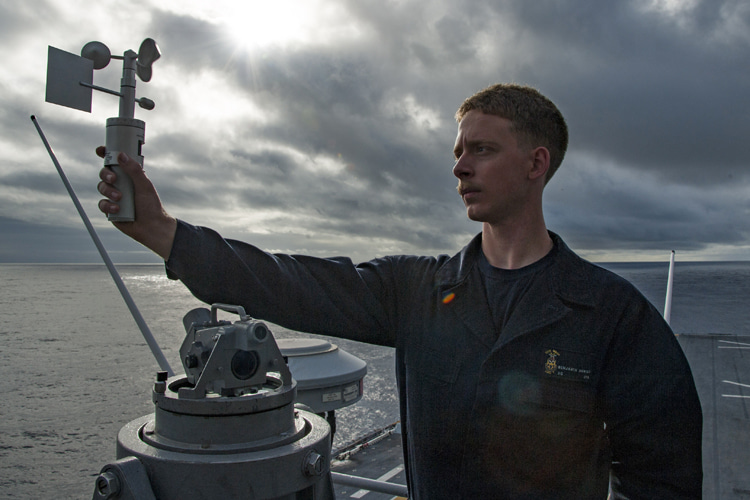The anemometer is a device used to measure wind speed and wind pressure.
It is an essential tool for meteorologists, who study weather patterns, and physicists, who study and learn how air moves.
But anemometers can also be used in engineering, aviation, and many other fields.
From Early Wind Measurement Devices to Modern Instruments
The history and development of anemometers can be traced back to the 1450s when Italian artist and architect Leon Battista Alberti suggested the theory of a device to measure wind velocity.
Alberti's invention was a mechanical anemometer with a disc placed perpendicular to the wind direction.
The angle of inclination of the disc indicated the wind velocity.
This design was improved upon by Italian scientist Evangelista Torricelli in the 1640s, who added a barometer to measure air pressure.
In the 18th century, British scientist John Dalton used a simple anemometer with four hemispherical cups to measure wind speed.
His creation was then fine-tuned by Irish researcher John Thomas Romney Robinson in the 1840s, who invented the hemispherical cup anemometer.
This instrument consisted of four hemispherical cups attached to horizontal arms.
The cups rotated horizontally with the wind while a combination of wheels recorded the number of revolutions in a given time.
In the 20th century, anemometers became increasingly sophisticated and versatile.
The first electronic anemometer was invented in the 1930s. It used a thermocouple to measure wind speed.
Today, anemometers can be found in various sizes and shapes.
They are used in a broad range of applications, including weather forecasting, aviation, and renewable energy.
The history and development of anemometers have been marked by several innovations and improvements, from early mechanical designs to modern electronic instruments.
Nevertheless, one thing never changed - anemometers continue to be an essential tool for understanding and predicting weather patterns.
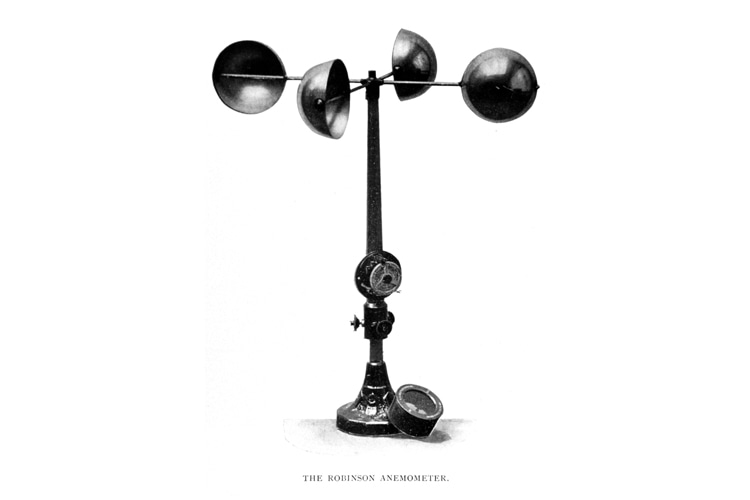
Types of Anemometers and Their Uses
Wind measuring gadgets come in a variety of shapes and sizes.
The are three main types of anemometers;
- Cup anemometers;
- Vane anemometers;
- Ultrasonic anemometers;
Cup Anemometers
Cup anemometers are the most common type of anemometer.
They consist of three or four cups attached to horizontal arms, which rotate with the wind.
The speed of the cups is used to calculate the wind speed.
Cup anemometers are often used in weather stations and ships, as they are simple, reliable, and relatively inexpensive.
Vane Anemometers
Vane anemometers, also known as wind vanes, are similar to cup anemometers but use a vertical vane instead of cups.
The vane rotates with the wind, and the angle of the vane is used to calculate the wind speed.
Vane anemometers are often used in aviation and meteorology as they are more sensitive and accurate than cup anemometers.
But they can also be seen in windsurfing, kiteboarding, and sailing in general.
Ultrasonic Anemometers
Ultrasonic anemometers use sound waves to measure wind speed.
They emit a sound wave and measure the time it takes for the sound wave to travel to and from a target.
The speed of the wind is calculated based on the time it takes for the sound wave to travel a known distance.
Ultrasonic anemometers are often used in wind turbines and meteorology.
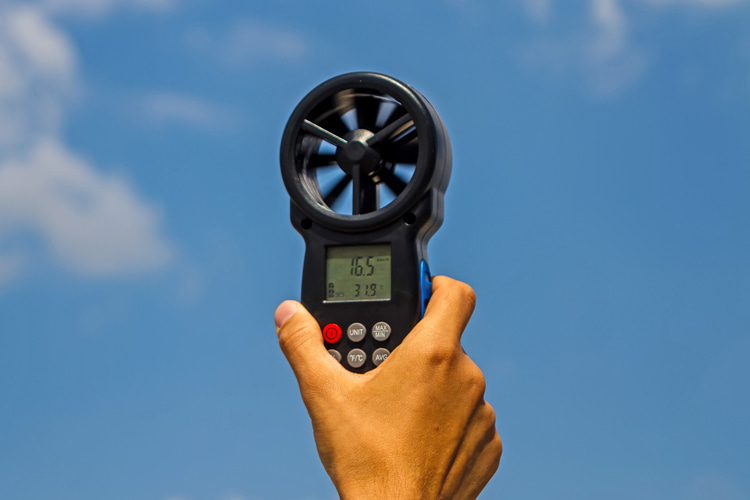
Principles of Operation
An anemometer typically consists of three to four cups or vanes attached to horizontal arms, which are, in turn, attached to a vertical rod.
As the wind blows, it causes the cups or vanes to rotate - the stronger the wind, the faster the cups or vanes will rotate.
This causes the vertical rod to spin.
The speed of the wind can be measured by counting the number of rotations of the cups or vanes in a specific amount of time.
This is typically done using a "wind speed meter" or a "wind vane," which is connected to the anemometer and records the number of rotations over a given period.
The wind direction can be determined by the direction the cups or vanes are facing when they are not rotating.
Anemometers are important for meteorologists, who use them to study weather patterns and predict future weather conditions.
Physicists also use them to study the movement of air, and they are often found in wind tunnels to study the effects of wind on objects, for example, a Formula 1 car.
Anemometers are also used in numerous fields, including aviation, engineering, and construction, where wind speed and direction are key factors to consider.
In meteorology, accurate wind measurements are essential for understanding and predicting weather patterns.
Wind measurements help meteorologists understand how wind influences temperature, humidity, and other weather factors and can be used to develop accurate weather forecasts.
They can be useful in determining the direction and speed of storm systems, which is crucial for predicting their movement and intensity.
In aviation, wind measurements are used to determine the speed and direction of the wind at different altitudes.
This information is critical for pilots, who use it to plan their flight paths and adjust their aircraft's performance.
For example, wind measurements can help pilots determine the speed and direction of head and tailwinds, which can affect an aircraft's speed and fuel consumption.
In renewable energy, wind data are used to assess the feasibility of wind energy projects.
Accurate wind measurements are important for predicting the amount of electricity that a wind turbine will produce, which is a relevant factor in determining the economic viability of a wind energy project.
Anemometers are also used to optimize the design of wind turbines, including the size, shape, and orientation of the blades, to maximize their efficiency and power output.
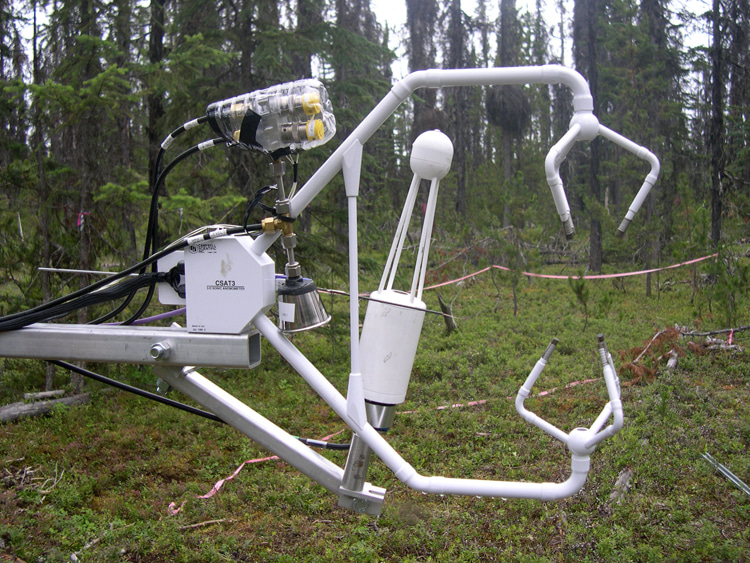
Challenges and Limitations
Anemometers face challenges and limitations in certain environments, such as extreme temperatures and high winds.
These challenges can affect the accuracy and reliability of the wind measurements they provide.
One of the main challenges of using anemometers is their ability to operate in extreme temperatures.
Anemometers are typically designed to operate within a specific temperature range.
If the temperature falls outside this range, the wind-measuring device may not function properly.
For example, anemometers designed for cold climates may not function correctly in hot temperatures and vice versa.
This can make it difficult to use anemometers in specific environments, such as deserts or polar regions, where temperatures vary widely.
Another challenge of using anemometers is their ability to withstand high winds.
Interestingly, anemometers are designed to measure wind speed but can also be affected by wind.
In high winds, anemometers may be damaged or blown over, which can cause them to stop working or give inaccurate readings.
This can be especially problematic in areas with strong and gusty winds, such as on mountaintops or near the coast.
In addition to these challenges, anemometers can also be affected by other factors, such as air debris or environmental moisture.
Debris, such as dust or leaves, can interfere with the movement of the anemometer's cups or vanes, causing them to spin slower or faster than expected.
Moisture, such as rain or snow, can also affect the anemometer's performance, causing it to rust or freeze.
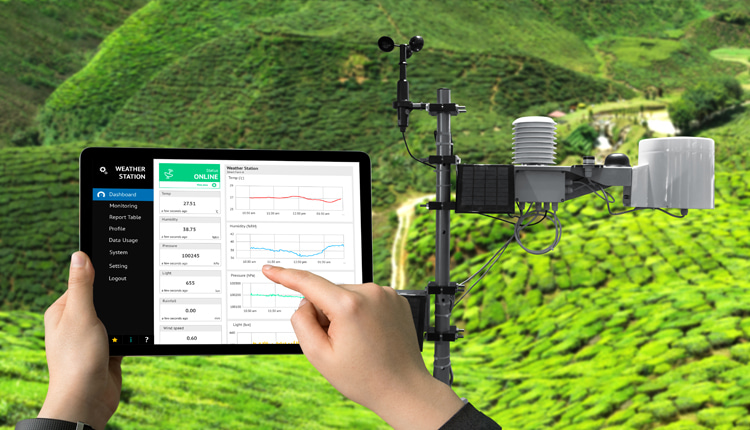
Innovation and Advancements in Technology
Over the years, many advancements and innovations in anemometer technology have been made, including developing digital displays and wireless connectivity.
In the past, anemometers typically used mechanical dials or pointers to display wind speed and direction.
These displays were often difficult to read and could be affected by factors such as vibration or moisture.
With the advent of digital displays, anemometers can now provide clear and easy-to-read displays of wind speed and direction.
Digital displays can also be more accurate and reliable than mechanical displays and can be easily integrated into other systems and devices.
Another recent innovation in anemometer technology is the use of wireless connectivity.
In the past, anemometers were often connected to other devices using cables or wires, which could be inconvenient and limiting.
With wireless connectivity, anemometers can now connect to other devices and systems without cables or wires.
This allows for more flexibility and ease of use and can enable anemometers to be used in a broader range of applications and environments.
In addition to these innovations, there have also been advancements in the design and performance of anemometers.
Modern anemometers are often more compact, lightweight, and rugged than their predecessors, making them easier to transport and use in various environments.
They are also often more accurate and sensitive than older anemometers, which can provide more detailed and precise wind measurements.
All these innovations have made anemometers more convenient, accurate, and reliable and have opened up new possibilities for their use in multiple applications and environments.
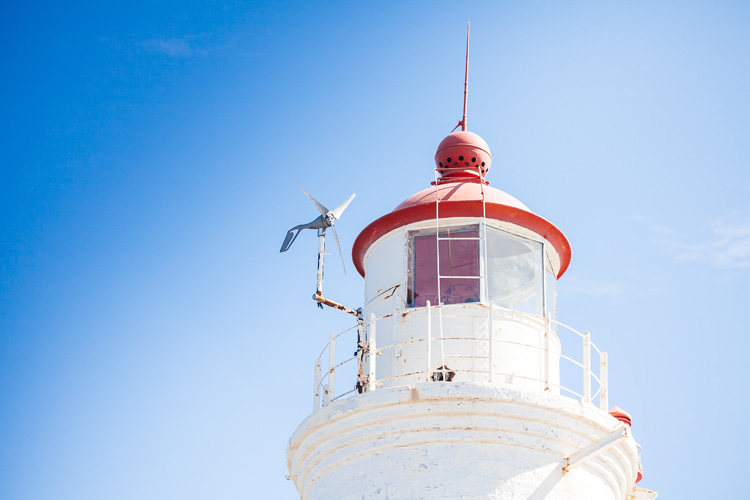
Predicting and Mitigating Effects of Natural Disasters
Anemometers are indispensable tools for predicting and mitigating the effects of natural disasters, such as hurricanes and tornadoes.
In meteorology, scientists use anemometers to study weather patterns and predict future weather conditions.
By measuring wind speed and direction, meteorologists can determine the direction and intensity of storm systems, such as hurricanes and tornadoes.
This data is crucial for predicting the movement and strength of these storms, which can help to reduce or mitigate the impact of natural disasters on communities.
In aviation, experts use wind measurements to determine the speed and direction of the wind, which can affect the aircraft's performance.
This information is vital for pilots, who can use it to plan their flight paths and avoid areas affected by strong winds, such as the eye of a hurricane.
In engineering, professionals use wind measurements to design and build structures that can withstand the forces of natural disasters.
For example, wind measurements can help engineers determine the wind speeds a building or bridge will likely encounter.
All data provided can help them design solid and resilient structures to withstand these forces.
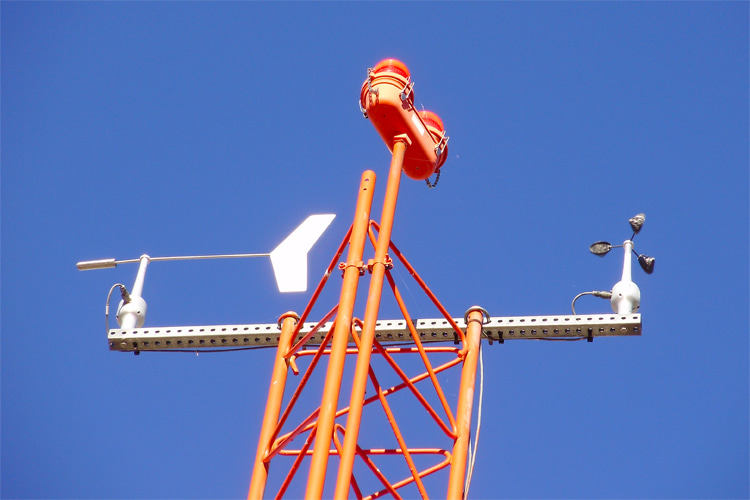
Anemometers in Engineering
Anemometers are also important tools in wind engineering, where they are used to design structures resistant to wind damage.
Wind engineering studies the effects of wind on structures and the design of systems that can withstand these effects.
In this particular discipline, anemometers are used to measure the wind speeds a structure is likely to encounter, which is a critical factor in determining the structure's design.
For example, anemometers can measure wind speeds at different heights and in distinct directions, which can help engineers determine the wind loads a structure will experience.
Based on the wind measurements provided by anemometers, engineers can design structures using reinforced concrete, steel, or other strong and flexible materials to resist wind loads.
Engineers can also use computational modeling and other techniques to simulate the effects of wind on a structure and to determine the most effective design for a given location.
In addition to their use in the design of structures, anemometers are also used to monitor the performance of existing ones.
By measuring the wind speeds experienced by a structure over time, engineers can determine if the structure is performing as expected or is experiencing excessive wind loads.
This information can be used to adjust the structure or its surroundings to reduce the risk of wind damage.
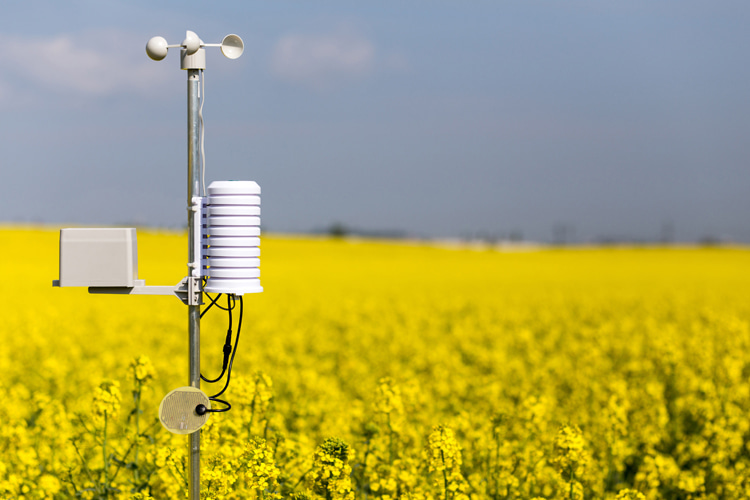
Optimizing Wind Turbines
Wind power is a clean and renewable energy source with many environmental benefits.
Unlike fossil fuels, which release carbon dioxide and other pollutants into the atmosphere, wind power produces no carbon emissions and has a minimal environmental impact.
Anemometers are important tools used to optimize the placement and operation of wind turbines, which are the primary means of generating electricity from wind.
One of the key environmental benefits of wind power is its ability to reduce greenhouse gas emissions.
When fossil fuels are burned to generate electricity, they release large amounts of carbon dioxide and other pollutants into the atmosphere, contributing to global warming and climate change.
In contrast, wind turbines produce no emissions when generating electricity, meaning that wind power is a clean and sustainable energy source.
In addition to reducing greenhouse gas emissions, wind power has other environmental benefits.
For example, wind energy can help to reduce air and water pollution, as it does not produce toxic waste and other pollutants associated with fossil fuels.
Wind energy can also help to conserve natural resources, as it does not rely on the extraction and processing of fossil fuels.
Anemometers are fundamental tools used to optimize the placement and operation of wind turbines.
By measuring wind speed and direction, anemometers can help engineers and other experts determine the best locations for wind turbines and design the most efficient and effective wind turbine systems.
Anemometers can also be used to monitor the performance of existing wind turbine systems, which can help identify any issues or problems and ensure that the turbines operate at their maximum efficiency.
The Future of Anemometers
The future of anemometer technology is likely to involve continued improvements in accuracy, durability, and versatility.
For example, future anemometers may be more accurate than existing devices in measuring wind speeds over a wider range of conditions.
These new anemometers may also be more durable and able to withstand harsh environments such as high winds or extreme temperatures.
Another potential development in anemometer technology is using sensors and other electronic components to improve the versatility of anemometers.
For instance, anemometers may be equipped with sensors that can measure temperature, humidity, and other factors affecting wind speed and direction.
This information can be used to improve the accuracy of wind speed measurements and provide additional insights into wind behavior.
In addition to these developments, the future of anemometer technology may also involve using new materials and manufacturing techniques.
For example, anemometers may be made from lightweight and durable materials, such as advanced composites, that can withstand the forces of wind and other environmental conditions.
This can improve the performance and reliability of anemometers and reduce the cost of these instruments.
These advances in anemometer technology can help improve our understanding of wind and better use of this natural resource.
